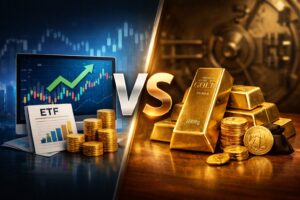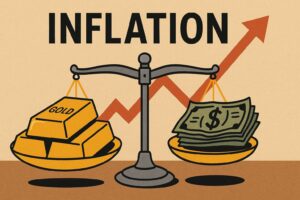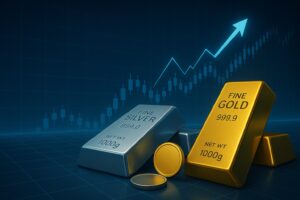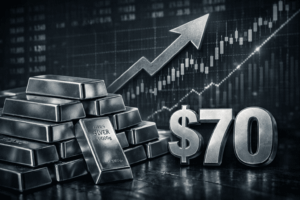China just turned rare earth metals into a geopolitical weapon — and the West is waking up to how exposed it really is.
In July 2025, Beijing tightened export restrictions on key rare earth elements, cutting off Western manufacturers from the raw materials that power modern life — from EV motors and wind turbines to smartphones and missile guidance systems. The timing wasn’t accidental. It came days after Washington floated a new round of tariffs, escalating what’s quickly becoming an all-out economic cold war.
The result? A global scramble to rebuild a supply chain that took decades to outsource.
The Hidden Backbone of Modern Industry
Rare earth metals may sound niche, but they’re as essential today as oil was in the 20th century. Without neodymium, dysprosium, and terbium, there’s no green energy revolution, no advanced weaponry, and no high-speed computing.
But they’re not the only critical materials caught in this supply crunch.
Silver has become indispensable to the energy transition — every solar panel requires it for conductivity, and EV electronics depend on it. Global silver demand from the solar sector alone has surged 20% year-over-year, according to the Silver Institute, while mine supply struggles to keep pace.
Nickel faces similar pressure. High-performance EV batteries — the kind needed to compete with Tesla — require nickel-rich cathodes. Indonesia controls roughly 50% of global nickel production, and like China with rare earths, it’s leveraging that position by restricting raw ore exports to force downstream processing at home.
What ties these materials together? They’re all scarce, strategically vital, and concentrated in the hands of a few nations. That makes them leverage points in the new resource wars reshaping global trade.
China now controls roughly 70% of global rare earth production and close to 90% of refining capacity, according to World Bank estimates. That dominance gives Beijing enormous leverage — not just over manufacturing, but over the strategic technologies defining the next era of growth.
Western nations, meanwhile, are playing catch-up. The U.S. and Europe are fast-tracking domestic mining and refining projects, but Goldman Sachs warns that most won’t be operational until at least 2028 — leaving three critical years of vulnerability. Until then, the West remains dependent on a handful of suppliers for the building blocks of its clean energy and defense ambitions.
Economic Nationalism Is Back — and It’s Here to Stay
Resource nationalism — once considered a relic of the 1970s — has roared back in the 2020s. From oil to semiconductors, nations are fighting to secure their own strategic materials. Now, rare earth metals are joining that list, alongside nickel, lithium, and cobalt.
Governments are pouring billions into reshoring critical supply chains, but the deeper issue isn’t just access — it’s trust. In an era when political alliances are shifting and inflation remains sticky, commodities that can’t be printed or hacked are taking on new importance.
That’s why investors are watching this story closely. Supply shocks in rare earths often spill over into broader commodity markets, raising input costs across the tech, auto, and energy sectors — a trend that could have ripple effects on inflation and monetary policy.
Gold and Silver: The Ultimate Hedge in the Resource Wars
The rare earth story isn’t just about technology — it’s about sovereignty, scarcity, and the value of real assets. And in that sense, gold and silver belong in the same conversation.
Just as nations hoard rare earths to maintain strategic power, central banks are hoarding gold to maintain financial independence. The World Gold Council reported record central bank gold buying in 2024 — led by emerging markets seeking neutral, hard reserves free from counterparty risk.
Silver occupies a unique dual role: it’s both an industrial workhorse and a monetary metal. While demand from solar, EVs, and electronics continues to climb, investors are rediscovering silver’s role as portfolio insurance — a tangible asset that holds value when supply chains fracture and currencies wobble.
Mike believes that this dual role will be the reason silver will outperforms gold 4-to-1 during this current precious metals bull market.
The same forces driving the rare earths race — deglobalization, inflation, and geopolitical fragmentation — are fueling a global return to tangible stores of value.
Investors looking beyond short-term headlines see a clear throughline: when trust in the system breaks down, tangible assets rise — whether that’s critical minerals or precious metals.
The Takeaway
The scramble for rare earth metals is more than an industrial story — it’s a sign that the global economy is shifting from abundance to competition. The same forces that made oil the geopolitical weapon of the 20th century are now shaping the race for the materials of the 21st — from neodymium and nickel to silver and gold.
For investors, it’s a reminder that the next decade will reward those who think like nations — securing what’s scarce, tangible, and real.
In a world built on fragile supply chains and financial promises, owning physical assets — from rare earths to precious metals — is owning certainty.
People Also Ask
Why are rare earth metals so important in 2025?
Rare earth metals power nearly every modern technology — from electric vehicles and wind turbines to smartphones and defense systems. In 2025, China’s dominance over rare earth production has made them a geopolitical flashpoint. For investors, these materials highlight the value of real, tangible assets — like gold and silver — that can’t be restricted or printed.
How much of the world’s rare earth supply does China control?
China controls about 70% of global rare earth production and nearly 90% of refining capacity, according to the World Bank. That means Western industries are heavily dependent on Beijing for key industrial inputs — a dynamic that’s pushing nations and investors alike toward resource diversification.
What does the rare earth metals shortage mean for inflation?
Supply disruptions in rare earths raise production costs across industries — from electronics to renewable energy — which can ripple through to consumer prices. Historically, periods of commodity scarcity and inflation have benefited assets like gold, which serves as a hedge against currency debasement.
How do rare earth metals compare to gold and silver as investments?
Unlike gold and silver, rare earth metals aren’t easily investable for individuals — they’re industrial commodities with complex supply chains. Precious metals, on the other hand, offer both liquidity and safe-haven protection.
Is silver also affected by the clean energy boom?
Yes — silver demand is soaring because it’s essential for solar panels, EVs, and electronics. The Silver Institute reports a 20% year-over-year jump in industrial demand, while mine supply lags. This growing imbalance is one reason many investors are choosing to Buy Silver as both an industrial and monetary asset.
Get Gold & Silver Insights Direct to Your Inbox
Join thousands of smart investors who receive expert analysis, market updates, and exclusive deals every week.









